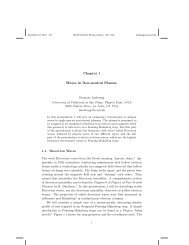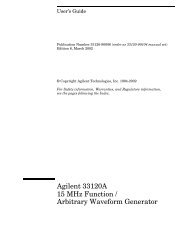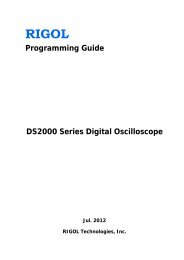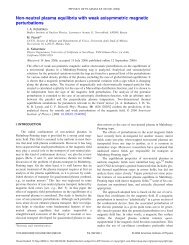ion-induced instability of diocotron modes in electron - Nonneutral ...
ion-induced instability of diocotron modes in electron - Nonneutral ...
ion-induced instability of diocotron modes in electron - Nonneutral ...
You also want an ePaper? Increase the reach of your titles
YUMPU automatically turns print PDFs into web optimized ePapers that Google loves.
Broadly, the different bounce-averaged azimuthal drifts <strong>of</strong><strong>electron</strong>s and <strong>ion</strong>s tends to polarize the <strong>diocotron</strong> modedensity perturbat<strong>ion</strong>s, thereby develop<strong>in</strong>g <strong><strong>in</strong>stability</strong>similar to the classical flute MHD-<strong><strong>in</strong>stability</strong> <strong>of</strong> neutralplasmas conf<strong>in</strong>ed <strong>in</strong> non-uniform magnetic fields. Themajor factor that dist<strong>in</strong>guishes charged plasma behavior<strong>in</strong> our experiment from neutral plasma conf<strong>in</strong>ement is thatthis charge separat<strong>ion</strong> ma<strong>in</strong>ly comes from the two speciessampl<strong>in</strong>g different radial electric fields at the plasmacolumn ends (prevalent importance <strong>of</strong> this effect fordouble-well traps was first ment<strong>ion</strong>ed by Pasqu<strong>in</strong>i andFajans 15,16 ). However, it allows us an easy control overthe effective drift separat<strong>ion</strong> <strong>of</strong> oppositely charge particles<strong>in</strong> the wave perturbat<strong>ion</strong>, by simply vary<strong>in</strong>g the ratio <strong>of</strong>the <strong>ion</strong> end transit time t end (by adjust<strong>in</strong>g the end lengthL end or the potentials) to the total bounce time t bnc .As a result, the measured trapped-<strong>ion</strong>-<strong><strong>in</strong>duced</strong> growthrates show a rather simple dependence( N N ) f ⎡1 cos( 2 )γ = × ⎣ − πτ τm i e m end bncverified <strong>in</strong> a broad range <strong>of</strong> relevant plasma and trapparameters. Hav<strong>in</strong>g just the l<strong>in</strong>ear reduct<strong>ion</strong> factor, N i /N e ,this strong exponential <strong><strong>in</strong>stability</strong> has no threshold on thesmallness <strong>of</strong> the <strong>ion</strong> fract<strong>ion</strong>, and without pay<strong>in</strong>g properattent<strong>ion</strong> it may lead to significant rate <strong>of</strong> particle radialtransport and losses <strong>in</strong> double-well conf<strong>in</strong>ementconfigurat<strong>ion</strong>s.ACKNOWLEDGMENTSThis work was supported by Nat<strong>ion</strong>al ScienceFoundat<strong>ion</strong> Grant No. PHY0354979.REFERENCESKabantsev and Driscoll[1] M. N. ROSENBLUTH and C. L. LONGMIRE,“Stability <strong>of</strong> Plasmas Conf<strong>in</strong>ed by MagneticFields,” Annals <strong>of</strong> Physics, 1, 120 (1957).[2] G. GABRIELSE et al., “Background-FreeObservat<strong>ion</strong> <strong>of</strong> Cold Antihydrogen with Field-Ionizat<strong>ion</strong> Analysis <strong>of</strong> Its States,” Phys. Rev.Letters, 89, 213401 (2002).[3] M. AMORETTI et al., “CompleteNondestructive Diagnostic <strong>of</strong> <strong>Nonneutral</strong>Plasmas Based on the Detect<strong>ion</strong> <strong>of</strong> ElectrostaticModes,” Phys. Plasmas, 10, 3056 (2003).[4] A. A. Kabantsev et al., “Trapped Particles andAsymmetry-Induced Transport,” Phys. Plasmas,10, 1628 (2003).[5] C. F. DRISCOLL, K. S. FINE and J. H.MALMBERG, “Reduct<strong>ion</strong> <strong>of</strong> Radial Losses <strong>in</strong> aPure Electron Plasma,” Phys. Fluids, 29, 2015(1986).[6] T. M. O’NEIL, “A Conf<strong>in</strong>ement Theory for<strong>Nonneutral</strong> Plasmas,” Phys. Fluids, 23, 2216(1980).⎤⎦ION-INDUCED INSTABILITY OF DIOCOTRON MODES[7] A. A. KABANTSEV and C. F. DRISCOLL,“Fast Measurements <strong>of</strong> PicoAmp Plasma FlowsUs<strong>in</strong>g Trapped Electron Clouds,” Rev. Sci.Instrum., 75, 3628 (2004).[8] K. S. FINE, W. G. FLYNN, A. C. CASS, and C.F. DRISCOLL, “Relaxat<strong>ion</strong> <strong>of</strong> 2D Turbulence toVortex Crystals,” Phys. Rev. Letters, 75, 3277(1995).[9] S. A. PRASAD and T. M. O’NEIL, “Waves <strong>in</strong> aCold Pure Electron Plasma <strong>of</strong> F<strong>in</strong>ite Length,”Phys. Fluids, 26, 665 (1983).[10] R. H. LEVY, J. D. DAUGHERTY, and O.BUNEMANM, “Ion Resonance Instability <strong>in</strong>Grossly <strong>Nonneutral</strong> Plasmas,” Phys. Fluids, 12,2616 (1969).[11] A. J. PEURRUNG, J. NOTTE, and J. FAJANS,“Observat<strong>ion</strong> <strong>of</strong> the Ion Resonance Instability,”Phys. Rev. Letters, 70, 295 (1993).[12] J. FAJANS, “Transient Ion ResonanceInstability,” Phys. Fluids B, 5, 3127 (1993).[13] M. R. STONEKING, M. A. GROWDON, M. L.MILNE, and R. T. PETERSON, “Poloidal ExBDrift Used as an Effective Rotat<strong>ion</strong>al Transformto Achieve Long Conf<strong>in</strong>ement Times <strong>in</strong> aToroidal Electron Plasma,” Phys. Rev, Letters,92, 095003 (2004).[14] G. BETTEGA et al., “ExperimentalInvestigat<strong>ion</strong> <strong>of</strong> the Ion Resonance Instability <strong>in</strong>a Trapped Electron Plasma,” Plasma Phys.Contr. Fus<strong>ion</strong>, 47, 1697 (2005).[15] T. PASQUINI and J. FAJANS, “Ion ResonanceInstability <strong>in</strong> a Double Well Trap,” Programme& Abstracts <strong>of</strong> 3 rd Internat<strong>ion</strong>al Conference onTrapped Charged Particles and FundamentalInteract<strong>ion</strong>s, Wildbad Kreuth, Germany, August2002, p. 83, 292 nd WE-Heraeus Sem<strong>in</strong>ar (2002).[16] T. PASQUINI and J. FAJANS, “Ion ResonanceInstability <strong>in</strong> a Double Well Trap,” Bull. Am.Phys. Society, Orlando, Florida, November 2002,Vol. 47, No. 9, p. 127, AIP (2002).TRANSACTIONS OF FUSION SCIENCE AND TECHNOLOGY VOL. 51 FEB. 2007 99








![WORKSHOP PARTICIPANTS LIST [pdf] - UC San Diego](https://img.yumpu.com/35298899/1/190x245/workshop-participants-list-pdf-uc-san-diego.jpg?quality=85)
